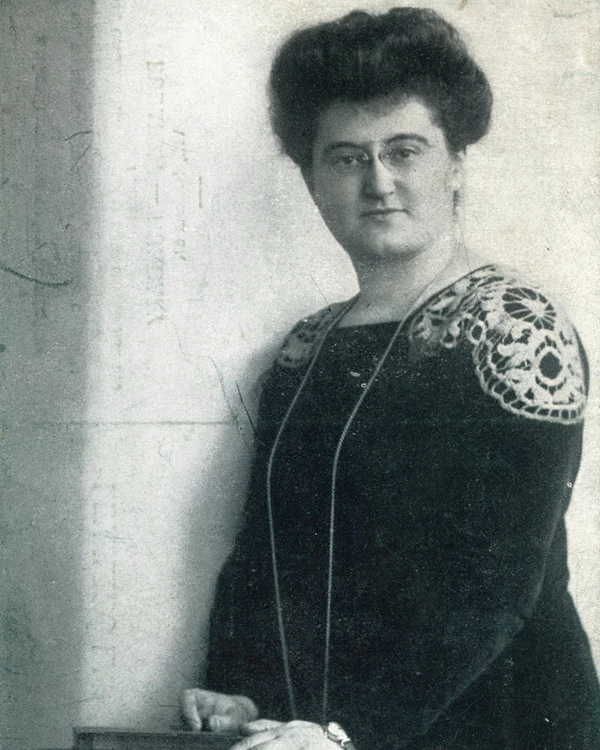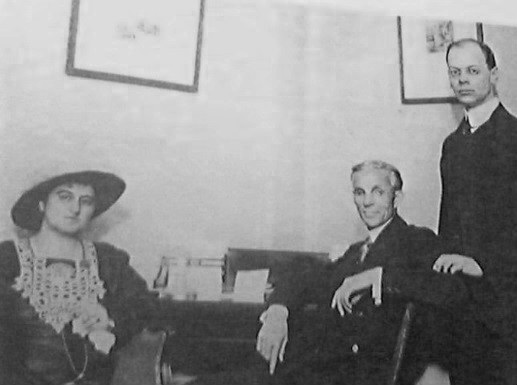Last updated: February 23, 2022
Person
Rosika Schwimmer

Public domain.
Rosika Schwimmer was a Hungarian peace activist, suffragist, and feminist. When she applied for United States citizenship, officials rejected her petition. The application asked if new citizens would be willing to take up arms to defend the country. Due to her pacifist beliefs, Schwimmer refused. Officials viewed her refusal as a sign of disloyalty and lack of commitment to the Constitution. In 1929, Schwimmer’s challenge to their decision went to the Supreme Court.
Can a peacemaker be dangerous?
Early Life and Activism
Rosika Schwimmer was born in Budapest, Hungary on September 11, 1877. She was the oldest child in a middle-class Jewish family.
Schwimmer devoted her early career to organizing working women in Hungary. During her twenties, she founded several national associations to improve working conditions and wages for women. She also advocated for birth control, marriage reform, and ending child labor.
In 1904, Schwimmer was invited to speak at the International Congress of Women in Berlin. She met Carrie Chapman Catt, a leader in the American women's suffrage movement and the president of the International Woman Suffrage Alliance (IWSA). Under Catt’s mentorship, Schwimmer began to advocate for women’s suffrage in Hungary and became the press secretary of the IWSA in London.
In 1911, Schwimmer married Paul (or Pál) Bédy, a journalist. They had no children and divorced two years later.
Women’s Suffrage Activism
On July 28, 1914, the assassination of Archduke Franz Ferdinand sparked the outbreak of World War I. Due to hostility toward Hungarians in Great Britain, Schwimmer came to the United States. She became involved with the American suffrage movement. Catt sent Schwimmer on a national tour to gain the support of German-speaking immigrants. In the span of months, she visited 60 cities.
Schwimmer also used her suffrage work to promote peace. She believed that if women could vote, they could pressure elected officials to support mediation in Europe. Schwimmer also gave lectures, collaborated with peace organizations, and participated in conferences for peace and women’s rights.
Although Schwimmer was an asset to the American suffragists, she and Catt had different priorities. Schwimmer disagreed with Catt’s single-minded focus on women’s suffrage and shifted her attention to ending the war in Europe.
Anti-War Activism and the Peace Ship
Schwimmer collaborated with American peace activists to urge President Woodrow Wilson and other prominent Americans to intervene in WWI. Although Wilson remained committed to neutrality, Schwimmer convinced Henry Ford to act. In addition to seeking peace, Ford was motivated by publicity and the antisemitic belief that Jewish bankers financed the war for their own gain.
In late 1915, Ford joined Schwimmer and other peace activists aboard the “Peace Ship.” The photo at left depicts Schwimmer, Ford, and anti-war activist Louis P. Lochner on the ship. The delegation departed for Stockholm to organize a mediation conference among neutral nations in February 1916. The campaign failed to influence European leaders and was ridiculed by the press. Ford blamed its poor reception on Schwimmer and accused her of mismanaging his money.
After this effort failed, Schwimmer remained in Europe to advocate for peace. When the war ended in 1918, she became an official and diplomat within Hungary’s new government, until the communist revolutionary Béla Kun overthrew it in 1919. When Schwimmer refused to serve under his regime, she was exiled from Hungary and returned to the U.S.
United States v. Schwimmer
By the time Schwimmer moved to Chicago in 1921, public opinion had turned against her. During wartime, journalists criticized her peace activism as unpatriotic and depicted her as a troublemaker. Reporters, including “Searchlight” columnist Fred Marvin, frequently questioned her loyalty and accused her of being a German spy, a Bolshevik, the source of Henry Ford’s antisemitism, and a threat to national security. To combat these claims, Schwimmer filed several anti-libel lawsuits, but failed to restore her reputation.
In December 1924, Schwimmer applied for naturalization. She was convinced that "getting citizenship is the only means to disprove all the accusations and rumors against me.” Question 22 on a preliminary form asked “If necessary, are you willing to take up arms in defense of this country?” Schwimmer responded: “I would not take up arms personally.” Due to her pacifist beliefs, she was a conscientious objector to military service.
Schwimmer also believed that the question did not apply to her. As a woman approaching 50 years old, she was ineligible for combat. At a naturalization hearing, she testified that if taking up arms was a requirement of her citizenship, she would not comply. When naturalization officials objected to Schwimmer’s pacifism, she insisted her beliefs did not diminish her loyalty.
Some of Schwimmer’s opponents, including the Military Intelligence Association of Chicago, also tried to prevent her from gaining citizenship. The Association was a superpatriotic professional organization for reserve officers who monitored the population for “dangerous” and “subversive” people and activities. In 1926, Schwimmer wrote the organization's leader to defend her beliefs. “I have no sense of nationalism, only a cosmic consciousness of belonging to the human family,” she explained. Naturalization officials later used Schwimmer’s statement to claim that she could not be truly committed to the Constitution.
In late 1927, a Federal District Court Judge in Illinois rejected Schwimmer’s petition for citizenship. The following spring, the Seventh Circuit Court of Appeals overturned the decision. The Supreme Court agreed to hear the case.[1] On May 27, 1929, the Court issued its 6-3 decision denying Schwimmer’s eligibility for citizenship.
The Justices determined that Schwimmer’s influence on others was more harmful than her individual refusal to bear arms. Schwimmer had openly expressed that she intended to defend and contribute to the U.S. through her civic participation, which the Justices believed would spread disloyalty. They argued that Schwimmer’s gender-based argument was also invalid because her gender did not diminish her ability to influence others.
Later Life
After the case, Schwimmer continued to advocate for peace. Her friends and allies remained committed to her quest for citizenship. Due to her diabetes and deteriorating health, Schwimmer was unwilling to restart the extensive citizenship process. She also continued to draw the ire of journalists and superpatriotic organizations.
Near the end of her life, Schwimmer lived in New York City with her sister Franciscka. After a prolonged illness, Schwimmer died at Mount Sinai Hospital on August 3, 1948. Even then, she remained a woman without a country.
Impact
In the 1946 case Girouard v. United States, the Supreme Court overturned its decision in United States. v. Schwimmer. As a result of this ruling, people who apply for citizenship cannot be disqualified for being conscientious objectors.
Places of Rosika Schwimmer
[1] The Supreme Court met in the Old Senate Chamber of the U.S. Capitol Building between 1860 and 1935. The Capitol was designated a National Historic Landmark in 1960.
Bibliography
Flowers, Ronald B., and Nadia M. Lahutsky. “The Naturalization of Rosika Schwimmer.” Journal of Church and State 32, no. 2 (1990): 343–66. http://www.jstor.org/stable/23916971.
Herman, Susan N. “Rosika Schwimmer, Woman Without a Country.” American Civil Liberties Union. Published November 20, 2020. https://www.aclu.org/issues/rosika-schwimmer-woman-without-country.
Subject File: 1851-1953; Schwimmer, Rosika; 1 of 3. Box 73, Reel 52. National Woman Suffrage Association Records. Manuscript Division, Library of Congress. https://www.loc.gov/item/mss3413201897.
New York Times. “Rosika Schwimmer Dead at Age of 70; International Pacifist Guiding Spirit of Henry Ford 'Peace Ship' in First World War.” August 4, 1948. https://nyti.ms/3oQnXMx.
Threlkeld, Megan. “Citizenship, Gender, and Conscience: United States v. Schwimmer.” Journal of Supreme Court History 40, no. 2 (July 2015): 154-171. https://doi.org/10.1111/jsch.12071.
Wenger, Beth S. “Radical Politics in a Reactionary Age: The Unmaking of Rosika Schwimmer, 1914-1930.” Journal of Women's History 2, no. 2 (1990): 66-99. https://doi.org/10.1353/jowh.2010.0133.
Wenger, Beth. “Rosika Schwimmer.” Shalvi/Hyman Encyclopedia of Jewish Women. Published December 31, 1999. Jewish Women’s Archive. Accessed January 18, 2022. https://jwa.org/encyclopedia/article/schwimmer-rosika.
The content for this article was researched and written by Jade Ryerson, an intern with the Cultural Resources Office of Interpretation and Education.
